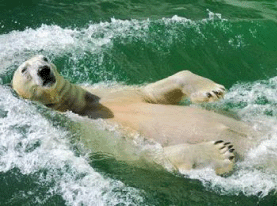| |
 |
| |
| 1. Glaciers Melting and drowning
The global warming is the major cause of glaciers melting. The polar bears may reduce 2/3 by 2050 and polar bears in Alaska will extinct. Fish and wildlife service of US suggested listing polar bears as endangered species in "Endangered Species Law" in January 2007. Polar bears hunt seals on ice. However, the melting by global warming may threat polar bear's living area.
US scientists found 4 polar bear died by drowning in Beaufort Bay in 2004. This is a real taunt for polar bears, who were named as swimming master and the traveller on the floating ice. |
| |
Polar bear was born to be a swimming master. The streamline body plus the big paws like two paddles can help them swim 40 to 50 kilometers. Polar bears often travel thousand kilometers to search for food and they rest on floating ice. The drowning is not occasional because the researcher Julian Dowdeswell in Scott arctic research center located in Britain found two more dead polar bears because of drowning in 2006. She said: "I saw two polar bears in Svalbard island in Norway near arctic. One is dead and the other one is dying." Polar Bears usually hunt near the edge of floating ice. Julian Dowdeswell told that the two bears was standing on one floating ice and then drop into the water because of the ice melting.
The words may be not that persuasive. However, in 208, scientists found 9 polar bears struggling in the water in western costal area in Alaska and they took this picture. |
|
 |
|
| |
Scientists of Minerals Management Service of United States found the 9 polar bears when they were exploring the Chukchi Sea (northwest of Alaska) by taking helicopter. Scientists found that the 9 polar bears were swimming in a broad sea. The farthest bear is about 60 miles from the coast. Scientists guessed that those bears were floating on an ice and they were heading the land or another water. However, satellite camera showed the sea ice had disappeared. It meant that those bears also faced the challenges of living and they might be drowning to death too.
Polar bear is not aquatic animal. Sea ice is its home. It is possible for polar bears to swim 40 to 50 kilometers. But it will be challenging for them to swim 50 to 100 kilometers and there is a high risk of drowning. So the cause of the drowning is the distance from one sea ice is too far for them to swim to another. The long journey of hunting makes them exhausted, temperature dropped, and immunity reduced rapidly. It is even more dangerous for bears when storm came.
Scientists think it could be a normal phenomenon in arctic region. In the recent 20 years, more and more polar bears have to come a long way to hunt enough food due to the glaciers melting. The death of polar bears could rise significantly if the ice in arctic area is continuously melting down. |
| |
| 2. Pollutions and hermaphrodite
The researchers of wilding animals and plants found the new evidence that polar bear is facing another threat which is the chemical pollutions. Those chemicals are toxic chemicals used to reduce the flammability of sofa, clothing and carpet. A group of scientists together to warn that there polar bear is becoming hermaphrodite. They found PBDEs in polar bear's adipose tissue, particularly those living in east Greenland.
Evidence shows that PBDEs is the major cause of polar bear's hermaphrodite. There is one polar bear with hermaphrodite for every 50 polar bears.
Collin Butterfield, the leader of WWF said: " Arctic region is now becoming the recycle place of chemicals which is harming the wild animals in arctic region." Those chemicals are mainly from United States and west European countries. They are travelling by stream and wind to arctic region and they stay and eventually become part of the food chain. Polar bears are the major victim. |
| |
 |
| |
| Green, Green and Green
The climate changes threat the living area of polar bears but it is always not late to take action and put efforts. Followings are some ways to prevent greenhouse effect. |
| 1. Use environmental friendly appliances |
| If you the energy saving and low volume washer, you will help reduce CO2 by 199.76kg. If you can use cold water, you will help reduce CO2 by 227kg. |
| 2. Put an insulation cover on water heater |
| You can put an insulation cover on your water heater if you have used your water heater for over 5 years. It will help reduce CO2 by 45.4kg. Keeping the temperature not higher than 49 degree Celsius, it will reduce CO2 by 249.7kg. |
| 3. Use high efficient refrigerator |
| A high efficient and energy saving refrigerator can reduce CO2 by 204.3kg. |
| 4. Reduce and recycle |
| Reducing the wastes by 25% will result in CO2 reduced by 454kg. Recycling aluminum products, glass bottle, plastic, board and paper can reduce CO2 by 385.9kg. |
| 5. Walk or take public transit |
| Walk or take public transit three days a week and you will help reduce CO2 by 721.86kg. |
| 6. Turn off when not using |
| Turn off TV, DVD player or radio when not using. Turn off lights when not using. |
| |
| Other ways: |
1. Use the automatic thermo control
2. Use solar energy
3. Dry clothing by natural wind
4. Plant trees |
|

|
| Participation in the United Nations Children's Fund Poverty Reduction Project |
|
|
| |

 Partnership
Partnership  Members
Members  polarbear
polarbear  Newsroom
Newsroom  About Us
About Us  Contact Us
Contact Us  Return Policy
Return Policy  Privacy Notice
Privacy Notice  Terms and Conditions
Terms and Conditions